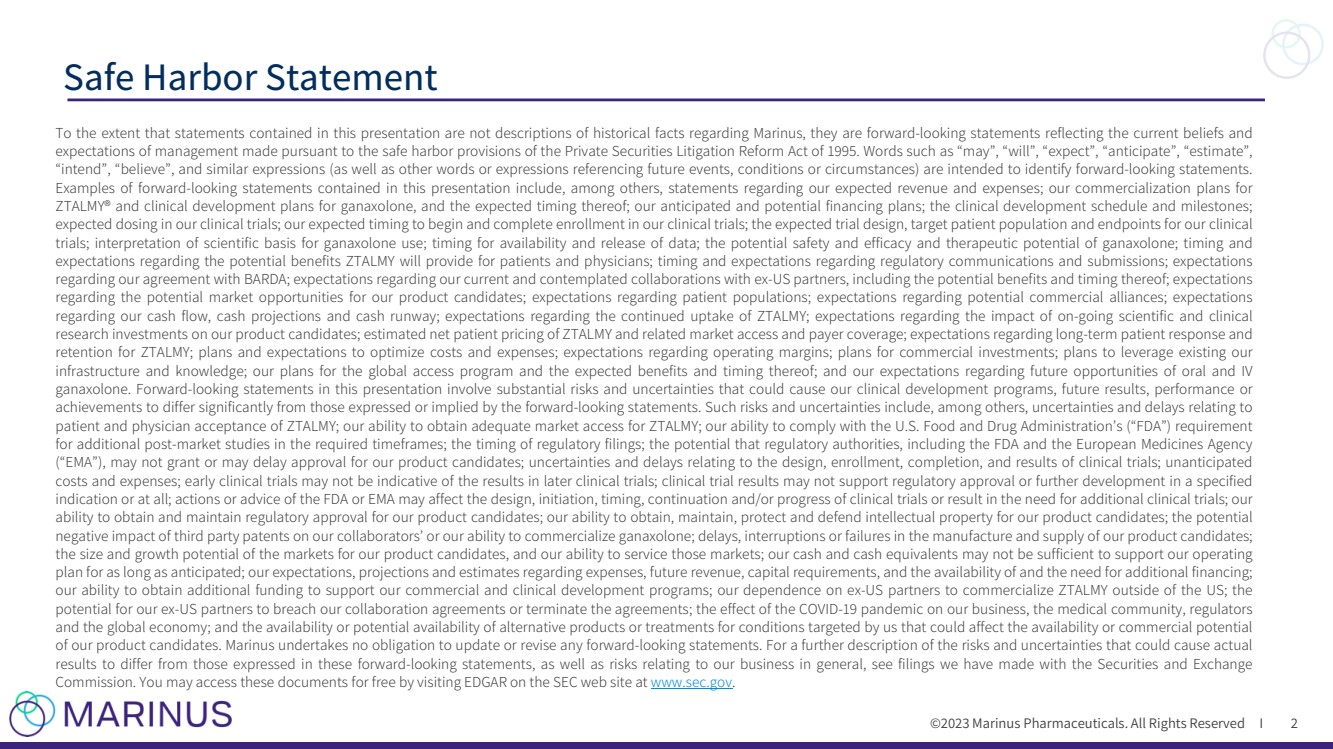
| ©2023 Marinus Pharmaceuticals. All Rights Reserved I
To the extent that statements contained in this presentation are not descriptions of historical facts regarding Marinus, they are forward-looking statements reflecting the current beliefs and
expectations of management made pursuant to the safe harbor provisions of the Private Securities Litigation Reform Act of 1995. Words such as “may”, “will”, “expect”, “anticipate”, “estimate”,
“intend”, “believe”, and similar expressions (as well as other words or expressions referencing future events, conditions or circumstances) are intended to identify forward-looking statements.
Examples of forward-looking statements contained in this presentation include, among others, statements regarding our expected revenue and expenses; our commercialization plans for
ZTALMY® and clinical development plans for ganaxolone, and the expected timing thereof; our anticipated and potential financing plans; the clinical development schedule and milestones;
expected dosing in our clinical trials; our expected timing to begin and complete enrollment in our clinical trials; the expected trial design, target patient population and endpoints for our clinical
trials; interpretation of scientific basis for ganaxolone use; timing for availability and release of data; the potential safety and efficacy and therapeutic potential of ganaxolone; timing and
expectations regarding the potential benefits ZTALMY will provide for patients and physicians; timing and expectations regarding regulatory communications and submissions; expectations
regarding our agreement with BARDA; expectations regarding our current and contemplated collaborations with ex-US partners, including the potential benefits and timing thereof; expectations
regarding the potential market opportunities for our product candidates; expectations regarding patient populations; expectations regarding potential commercial alliances; expectations
regarding our cash flow, cash projections and cash runway; expectations regarding the continued uptake of ZTALMY; expectations regarding the impact of on-going scientific and clinical
research investments on our product candidates; estimated net patient pricing of ZTALMY and related market access and payer coverage; expectations regarding long-term patient response and
retention for ZTALMY; plans and expectations to optimize costs and expenses; expectations regarding operating margins; plans for commercial investments; plans to leverage existing our
infrastructure and knowledge; our plans for the global access program and the expected benefits and timing thereof; and our expectations regarding future opportunities of oral and IV
ganaxolone. Forward-looking statements in this presentation involve substantial risks and uncertainties that could cause our clinical development programs, future results, performance or
achievements to differ significantly from those expressed or implied by the forward-looking statements. Such risks and uncertainties include, among others, uncertainties and delays relating to
patient and physician acceptance of ZTALMY; our ability to obtain adequate market access for ZTALMY; our ability to comply with the U.S. Food and Drug Administration’s (“FDA”) requirement
for additional post-market studies in the required timeframes; the timing of regulatory filings; the potential that regulatory authorities, including the FDA and the European Medicines Agency
(“EMA”), may not grant or may delay approval for our product candidates; uncertainties and delays relating to the design, enrollment, completion, and results of clinical trials; unanticipated
costs and expenses; early clinical trials may not be indicative of the results in later clinical trials; clinical trial results may not support regulatory approval or further development in a specified
indication or at all; actions or advice of the FDA or EMA may affect the design, initiation, timing, continuation and/or progress of clinical trials or result in the need for additional clinical trials; our
ability to obtain and maintain regulatory approval for our product candidates; our ability to obtain, maintain, protect and defend intellectual property for our product candidates; the potential
negative impact of third party patents on our collaborators’ or our ability to commercialize ganaxolone; delays, interruptions or failures in the manufacture and supply of our product candidates;
the size and growth potential of the markets for our product candidates, and our ability to service those markets; our cash and cash equivalents may not be sufficient to support our operating
plan for as long as anticipated; our expectations, projections and estimates regarding expenses, future revenue, capital requirements, and the availability of and the need for additional financing;
our ability to obtain additional funding to support our commercial and clinical development programs; our dependence on ex-US partners to commercialize ZTALMY outside of the US; the
potential for our ex-US partners to breach our collaboration agreements or terminate the agreements; the effect of the COVID-19 pandemic on our business, the medical community, regulators
and the global economy; and the availability or potential availability of alternative products or treatments for conditions targeted by us that could affect the availability or commercial potential
of our product candidates. Marinus undertakes no obligation to update or revise any forward-looking statements. For a further description of the risks and uncertainties that could cause actual
results to differ from those expressed in these forward-looking statements, as well as risks relating to our business in general, see filings we have made with the Securities and Exchange
Commission. You may access these documents for free by visiting EDGAR on the SEC web site at www.sec.gov.
Safe Harbor Statement
2 |